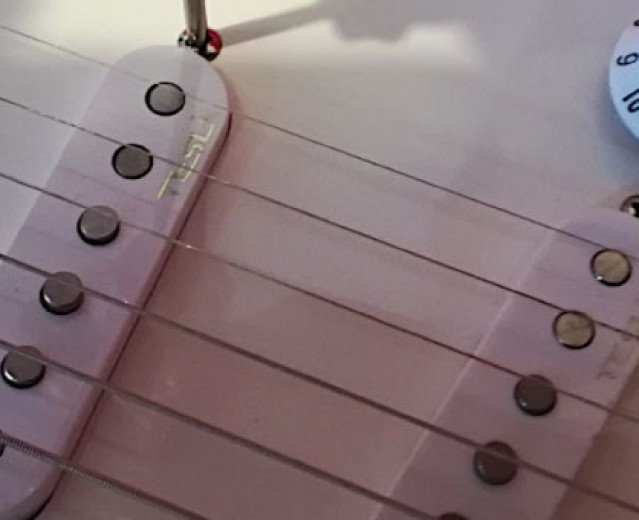How to adjust the distance of a
single coil pickup from guitar strings.
In this article you will find instructions and tips about pickup height setting on electric guitars, with special regard to single-coil models. Another article of this blog deals with double coil or humbucking pickups. This is part of the general setup of the guitar, that involves topics covered on the Soundsation blog, as neck truss-rod and action adjustments.
Before continuing you should
have:
All that verified, we can talk
about how self-adjusting single-coil pickups working on their mounting screws
on the pickguard or guitar body.
Magnets and coils
An electric guitar pickup is an electro-magnetic
transducer that converts string vibration into an electric signal. Easier
said, it is a set consisting in coils (isolated electric wire), magnets (permanent
magnets made of magnetizable materials as Iron, Nickel and Cobalt),
eventually some pole pieces, and an enclosure.
An electro-magnetic field surrounds the pickup
magnet and electrical particles move from the North pole to the South pole
of it. When this field is disturbed by string movements (strings must be
made of metal to interact), an electrical voltage is induced and it varies
as the string vibrations change. This variable electric signal reaches the
guitar jack output through the coil, volume and tone potentiometers, and then it is
send to the amplifier to be amplified and converted into sound waves.
It can therefore be understood that string-pickup
interaction has a lot to do with their distance, in addition to
the electro-magnetic field strength and shape.
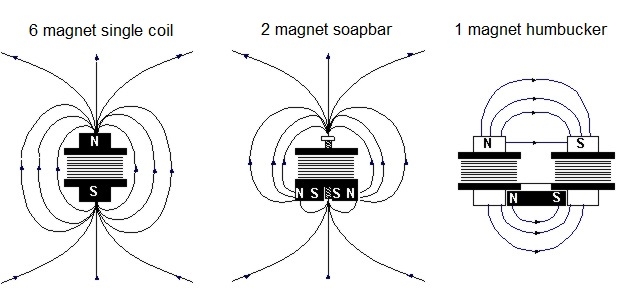
Common pickup magnets are made of Alnico
(Aluminium, Nickel, Cobalt and Iron) in its different classifications (2, 3, 4,
5) or ceramic (Iron oxide powder and Barium or Strontium carbonate ceramic),
also called ferrite, more fragile but cheaper. Ceramic magnets can be
recognised at sight thanks to their dark colour, whereas Alnico is shiny. Some
magnets are produced with the contribution of alternative materials, as Rare
Earth elements Neodymium and Samarium.
Kinds of single-coil pickups
Single-coil pickups consist of one isolated electrical wire coil and one or more magnets. This simple design has been firmly resisting since the '50s, but can easily make these pickups behave as antennas, thus picking up electromagnetic interferences, particularly hum from household electrical wiring (230V 50Hz or 120V 60Hz according to countries). This problem was solved by humbucking pickups we are talking about in another article.
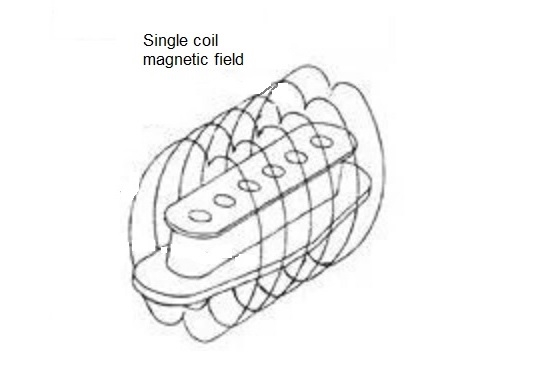 According to construction, single-coils can be of the following types:
According to construction, single-coils can be of the following types:
- a single wire coil is
vertically crossed by six real little magnets, as in Telecaster® and
Stratocaster® Fenders, in the Gibson Alnico Pickup or in the DeArmond Mod.200
(Gretsch Dyna-sonic)
- Among single-coils
there is also a design based on one or two large bar magnets placed
under the coil. Crossing cylinders or blades are just pole pieces that
facilitate the string-magnetic field contact. Some examples are the historic
Gibson P-90 (soap-bar), some powerful DiMarzio (SDS-1) and Bill Lawrence
(L-250) models, a lot of Fender looking single-coils destined to mid and
low-cost productions. Instead, Joe Barden single coil is crossed by two real blade
magnets
- Among peculiar
designs I would like to mention Lace Sensors, that feature a special
shielding (radiant field barrier) in order to avoid or minimize hum
- Active pickups have been on the market since the mid '70s, such as EMGs and other
following brands. In their design noise reduction and high output are obtained
by means of a built-in low impedance preamp and an accurate shielding.
So these models are real single-coils and are very quiet. They need a 9V
battery to work.
Starting from these general types, we have been seeing
attempts of all kinds through the decades, mixing coils, magnets, poles, sizes
and so on. CNC machines introduction helped making tight ultra-thin
wire windings in processes that were impossible in the '50s and
'60s. For more reference, there are excellent books about pickups and their evolution (*).
Setting single-coil pickups
Correctly setting a single-coil pickup is a pretty
easy operation. For example, Fender specs for Strat vintage style pickups
indicate a distance of 2.5 mm between
the 6th string and 2 mm between the 1st string and the
pole pieces, measures taken while keeping the strings pressed on the last fret.
I defy anyone to assess at sight a difference of half a millimetre! Original
values are given in inches – I slightly rounded them – and are the same for the
three pickups. Let's consider this a starting point, also good for
similar single-coils.

Let's start from the bridge
pickup
Start playing and listening to the
sound of open strings. Begin with the bridge pickup and lower it unscrewing
its pickguard screws: a quarter of turn usually produces audible variations.
Evaluate the sound you get: is it fuller or thinner? More or less rich in
harmonics? More or less brilliant? Too dry or too flat? Is the note
attack too hard?
Staying on the bridge pickup continue
by attempts, always doing minimal intervention on screws, and listen to the
result. At some point you will feel like the sound is becoming too thin
or weak. Go back to the previous position until you find the exact point the
sound seems to be the right one, or the sweet spot. Some experts use to
say in focus sound, because you are in fact adjusting the interaction
between the electro-magnetic field and the string vibrations as you were focusing a subject in an optical
lens.
This way of setting a pickup height
applies to your specific instrument with that pickup, those strings, based on
your essential taste and well trained ear.
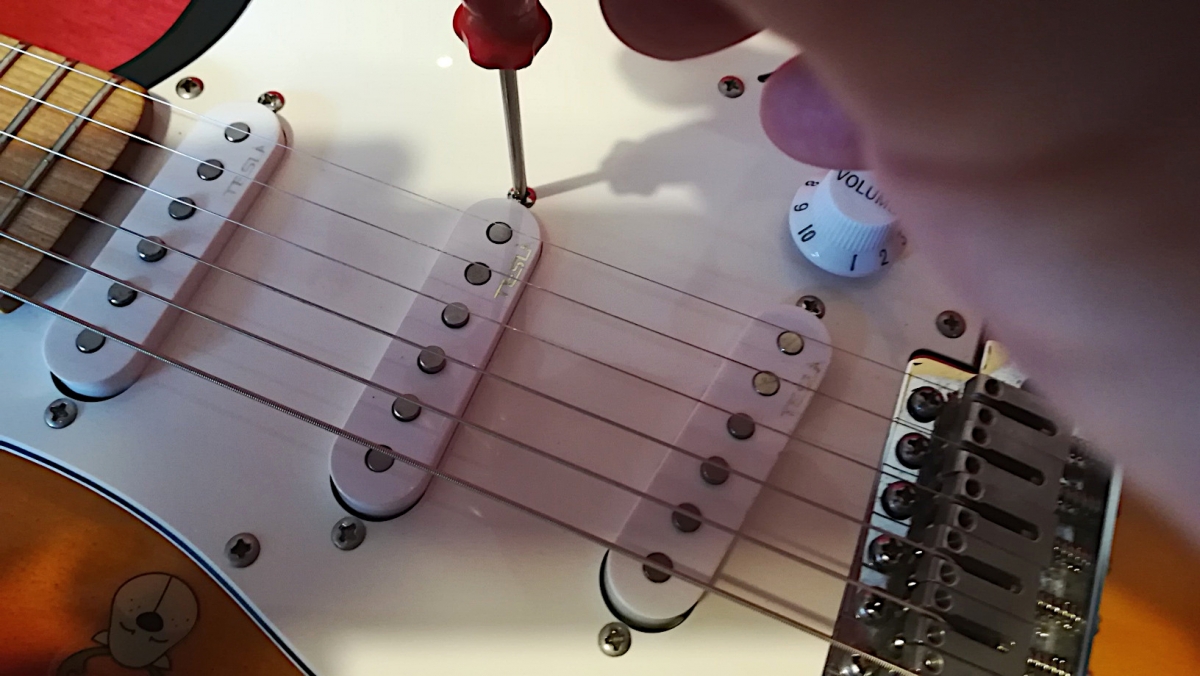
Sometimes, even on pros' guitars, it
happens to see pickups that are too close to the strings, searching for
a more powerful and bassier sound. Actually a pushed sound with little sustain
is obtained, since string vibration is limited by the pickup magnetic pull.
Back on this soon...
Let's go to the neck
pickup
Once you have set the toughest pickup, the
bridge one, you can handle the neck pickup, that always gives a louder and
fatter sound, because of its position where string vibration is broader. You
have to lower the pickup just enough to get a sound that matches the bridge
pickup in volume. Moving the switch from a pickup to the other, you should
not hear big level differences. This is valid for a Strat middle pickup too.
In fact, if the guitar has three pickups, the process is the same. Personally,
I always start with the bridge pickup, then go on to the neck one and complete
with the middle pickup.
Go on following the described ear
guided method to get better nuances from every pickup.

P-90s and other
single-coils
P-90 or soap-bar style pickups have a wider magnetic
field, extending on sides due to the use of two magnets under the coil and pole
pieces instead of real magnetic poles. They can be adjusted in the same way as
single-coils, but you have to consider a behaviour somehow halfway between
those and humbuckers.
Instead, DeArmond or Dyna-sonic
style pickups have massive magnets as poles. You have to set them
with care, both the whole pickup and the single poles.
Basically, if you keep the magnets low and
the full pickup close to the strings, the sound will resemble a P-90. In
contrast, if the pickup is moved away from the strings whereas the magnets are
kept near to them, it will sound like a fat brilliant single-coil. In-between
there are a lot of possible adjustments.
Due to appeal reasons, sometimes soap-bar
or DeArmond or humbucker looking pickups are used on lower priced guitars. Under
their covers you will often find Strat style pickups that must be adjusted as
Fender single-coils; but you have to know their nature beyond marketing
releases.
Lace (or hook) effect
Talking about single-coils, you must absolutely
consider that nearly always their magnets are the poles; in other words, the
six little cylinders! In the case of a Gibson style humbucking pickup, the magnetic field wraps the strings and the pickup
somehow like a loaf (the magnet stays horizontally under the coils),
whereas in the case of Fenders each magnet generates a magnetic flow pretty aimed
at the overhanging string. If the magnet (or pole) is too close to the string,
its vibration will be dampened or not naturally sounding, as if it were hold
by the pickup acting like a lace or hook. Sometimes it could be impossible
to set octave intonation and double notes or even fret buzz could be produced!
So, watch out for hot single-coil pickups with oversized
and boosted cylinder magnets, especially at the bridge position, where the
strings are closer to saddles and have less energy. Single-coils with a single
magnet under the coil produce a less direct magnetic flow and give less
trouble.
Refinements
The described adjusting method is good for
those with a certain experience. If you feel you are not able to follow
it, manufacturer's specs can be taken for granted. Turning to a luthier or a
skilled technician is always advisable.
Sometimes you can get unexpected
reactions. If you want more bass, do not raise the pickup at the wound string
side, instead lower it at the treble side; and vice versa.
A proof of successful setting comes from
listening to the switch middle positions: if the sound is not typical and
pleasant, you'll have to review something at least for one of the pickups.
If the pickups are very different from
each other, by example if the bridge pickup is a lot more powerful than the neck and middle ones, you'll have to turn to
splittable pickups or accept some compromise solutions: an audible difference
of volume or some drive sacrifice in the most powerful.
Poles and pole pieces
Single-coil pickups almost always have six
not adjustable cylindrical magnets or pole pieces. Length can be the same
for all (flat pole pieces) or varied according to the string gauges once
available (staggered pole pieces).
If you find screws in place of cylinders
and you notice clear volume differences among the strings, use the screws to
get a balance. Play, evaluate and screw or unscrew the poles until the strings
produce the same sound level. Start from the factory setting and try to follow
the fretboard radius, though your ear is always the final judge.
It is possible that something changes when
you switch from clean sounds to saturated sounds; there is nothing wrong
with retouching a pickup setting while an overdrive pedal is turned on.
Getting less problems
Undoubtedly pickups with blades and active
pickups are easier to adjust. The first ones because you don't have to
care about screw poles; the second ones because their magnetic field is not
excessive and their strength comes from an active circuit. In these cases we
can follow manufacturer's instructions. By example, an EMG pickup requires a
distance of 3 mm from the strings pressed at the last fret; thereafter adjust
at your own taste.
I have to mention Lace Sensor pickups again. Their
particular design greatly reduces magnetic field influence and points it to
the outside of pickup, practically cancelling any lace effect.
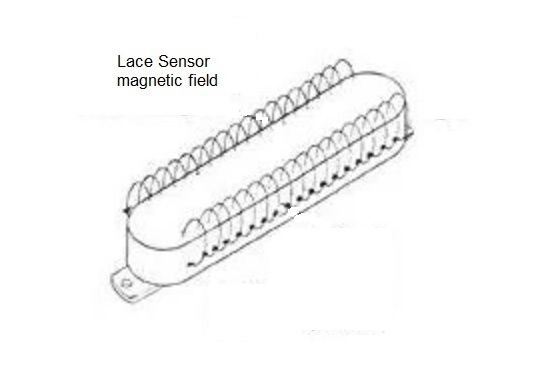 Still talking about magnetic field control,
similar solutions are implemented in Kingman pickups and in some DiMarzios (a suit
occurred between the companies in this regard), that however use two coils.
Still talking about magnetic field control,
similar solutions are implemented in Kingman pickups and in some DiMarzios (a suit
occurred between the companies in this regard), that however use two coils.
Have a good setting
As I said, in another article we deal with the adjustment of double coil or humbucking pickup, in which
case things are a little different and more elaborate. Information provided
here about single-coils should be enough to get a clear, full and balanced
sound from your guitar. But always beware of laces!
Fabrizio Dadò
(*)
M.Milan, Pickups - Centerstream Publishing, 2007
M.Milan/J.Finnerty,
The Gibson “P.A.F.” Humbucking Pickup - Centerstream Publishing, 2018.
